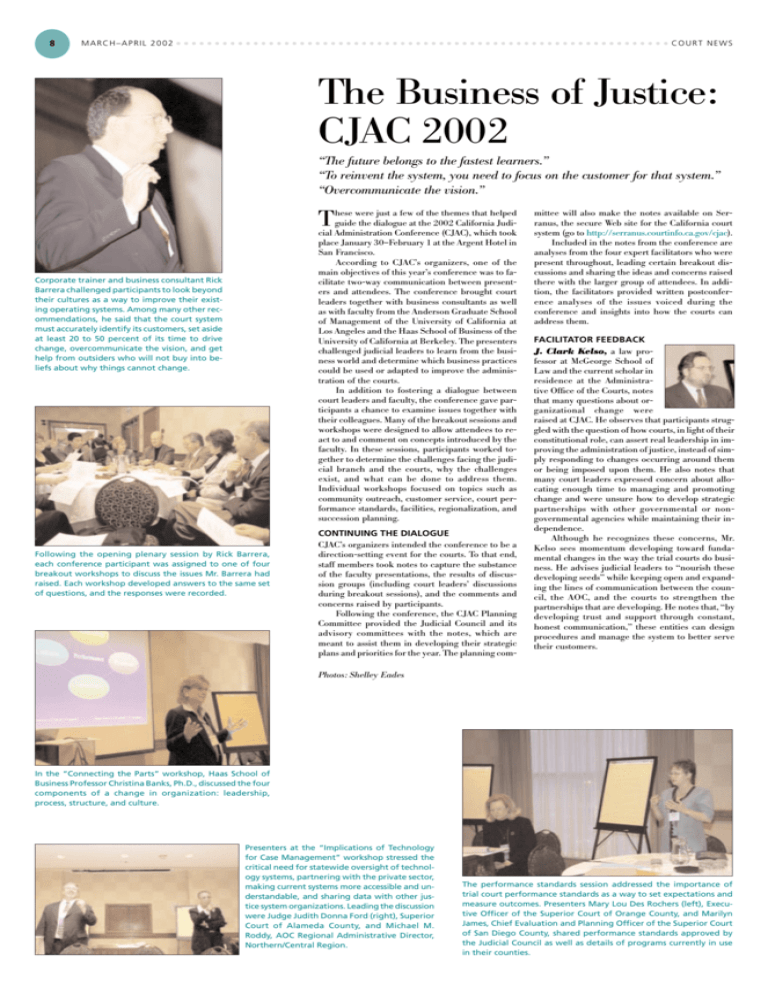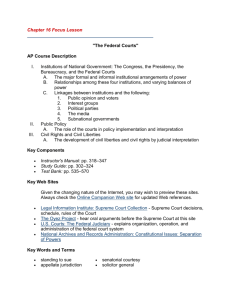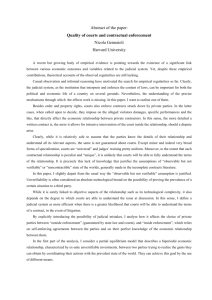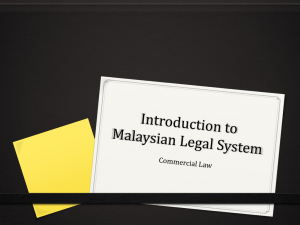02 Mar-Apr Court News
advertisement

8 MARCH–APRIL 2002 COURT NEWS The Business of Justice: CJAC 2002 “The future belongs to the fastest learners.” “To reinvent the system, you need to focus on the customer for that system.” “Overcommunicate the vision.” hese were just a few of the themes that helped guide the dialogue at the 2002 California Judicial Administration Conference (CJAC), which took place January 30–February 1 at the Argent Hotel in San Francisco. According to CJAC’s organizers, one of the main objectives of this year’s conference was to facilitate two-way communication between presenters and attendees. The conference brought court leaders together with business consultants as well as with faculty from the Anderson Graduate School of Management of the University of California at Los Angeles and the Haas School of Business of the University of California at Berkeley. The presenters challenged judicial leaders to learn from the business world and determine which business practices could be used or adapted to improve the administration of the courts. In addition to fostering a dialogue between court leaders and faculty, the conference gave participants a chance to examine issues together with their colleagues. Many of the breakout sessions and workshops were designed to allow attendees to react to and comment on concepts introduced by the faculty. In these sessions, participants worked together to determine the challenges facing the judicial branch and the courts, why the challenges exist, and what can be done to address them. Individual workshops focused on topics such as community outreach, customer service, court performance standards, facilities, regionalization, and succession planning. T Corporate trainer and business consultant Rick Barrera challenged participants to look beyond their cultures as a way to improve their existing operating systems. Among many other recommendations, he said that the court system must accurately identify its customers, set aside at least 20 to 50 percent of its time to drive change, overcommunicate the vision, and get help from outsiders who will not buy into beliefs about why things cannot change. Following the opening plenary session by Rick Barrera, each conference participant was assigned to one of four breakout workshops to discuss the issues Mr. Barrera had raised. Each workshop developed answers to the same set of questions, and the responses were recorded. CONTINUING THE DIALOGUE CJAC’s organizers intended the conference to be a direction-setting event for the courts. To that end, staff members took notes to capture the substance of the faculty presentations, the results of discussion groups (including court leaders’ discussions during breakout sessions), and the comments and concerns raised by participants. Following the conference, the CJAC Planning Committee provided the Judicial Council and its advisory committees with the notes, which are meant to assist them in developing their strategic plans and priorities for the year. The planning com- mittee will also make the notes available on Serranus, the secure Web site for the California court system (go to http://serranus.courtinfo.ca.gov/cjac). Included in the notes from the conference are analyses from the four expert facilitators who were present throughout, leading certain breakout discussions and sharing the ideas and concerns raised there with the larger group of attendees. In addition, the facilitators provided written postconference analyses of the issues voiced during the conference and insights into how the courts can address them. FACILITATOR FEEDBACK J. Clark Kelso, a law professor at McGeorge School of Law and the current scholar in residence at the Administrative Office of the Courts, notes that many questions about organizational change were raised at CJAC. He observes that participants struggled with the question of how courts, in light of their constitutional role, can assert real leadership in improving the administration of justice, instead of simply responding to changes occurring around them or being imposed upon them. He also notes that many court leaders expressed concern about allocating enough time to managing and promoting change and were unsure how to develop strategic partnerships with other governmental or nongovernmental agencies while maintaining their independence. Although he recognizes these concerns, Mr. Kelso sees momentum developing toward fundamental changes in the way the trial courts do business. He advises judicial leaders to “nourish these developing seeds” while keeping open and expanding the lines of communication between the council, the AOC, and the courts to strengthen the partnerships that are developing. He notes that, “by developing trust and support through constant, honest communication,” these entities can design procedures and manage the system to better serve their customers. Photos: Shelley Eades In the “Connecting the Parts” workshop, Haas School of Business Professor Christina Banks, Ph.D., discussed the four components of a change in organization: leadership, process, structure, and culture. Presenters at the “Implications of Technology for Case Management” workshop stressed the critical need for statewide oversight of technology systems, partnering with the private sector, making current systems more accessible and understandable, and sharing data with other justice system organizations. Leading the discussion were Judge Judith Donna Ford (right), Superior Court of Alameda County, and Michael M. Roddy, AOC Regional Administrative Director, Northern/Central Region. The performance standards session addressed the importance of trial court performance standards as a way to set expectations and measure outcomes. Presenters Mary Lou Des Rochers (left), Executive Officer of the Superior Court of Orange County, and Marilyn James, Chief Evaluation and Planning Officer of the Superior Court of San Diego County, shared performance standards approved by the Judicial Council as well as details of programs currently in use in their counties. COURT NEWS R. Dale LeFever, Ph.D., who has served on the faculty for the California Judicial Studies Program in Court Management, suggests that the judicial branch should more “clearly define the leadership role of judges” in relation to judicial administration; become comfortable with the pursuit of strategic partnerships; make a careful assessment of the core business of the courts; and take charge of managing its own image, accepting the fact that “it is not well understood as a branch of government.” The judicial branch must organize for change with the assumption that the ability to do so is a core part of its future, and judicial leaders need to get comfortable with the concept of “customer” and define those customers who will be given priority by the court. Dr. LeFever has taught in the areas of leadership development, strategic planning, and management of organizational change for federal and state courts since 1973. He makes the following specific recommendations: ◗ “Stay on the message” and obtain a commitment from people who will champion large-scale changes throughout the state. (Any major changes take five to seven years to become embedded in the culture and are fragile during that time.) ◗ Define the results the court exists to achieve and design an evaluation process, including the method for measuring success. ◗ Align training with statewide priorities and “make it the primary vehicle for implementing desired changes.” ◗ Extend the term of presiding judges, train them for this important role, and develop a succession plan for future presiding judges. ◗ Make the strategic planning process, the budget process, and the transition to unified courts function as interdependent pieces of a statewide approach. ◗ Empower leaders to manage both “the content and pace of change across the system.” The rationale for every change should be developed and communicated on the way to full implementation. Larry Sipes, who served as president of the National Center for State Courts (NCSC) from 1990 to 1995, concludes that the major challenge facing the courts is determining how to “maximize the effectiveness of the judicial branch while institutionalizing monumental changes in judicial branch governance, structure, and resources.” He identifies five areas that judicial leaders should focus on: customer service, strategic partnerships, strategic planning, communication, and leadership. At the customer service workshop, José Guillén, Executive Officer of the Superior Court of Riverside County, led a discussion on understanding the transformation of the courts from a case management entity into a problem-solving organization. He added that courts must understand the difference between customers and partners, and should recognize that serving the cause of justice starts with answering the phones in a courteous manner and having clerks treat court visitors with respect. MARCH–APRIL 2002 9 Mr. Sipes quotes Martin Luther King, Jr., to emphasize that the judicial branch must “rise above the narrow confines of individualistic concerns to the broader concerns” of justice. Ronald J. Stupak, Ph.D., who served as a Distinguished Scholar in Residence for the National Center for State Courts, wants CJAC participants to realize “the change process is both a rational and an emotional journey” that should be based on inclusive dialogue rather than hierarchical commands. Judicial leaders must welcome differing perspectives from experts outside the courts and must recognize that people do what they get rewarded for—in other words, actions speak louder than words. Dr. Stupak has served as dean of the Center for Effective Organizational Leadership and was a Distinguished Faculty Research Scholar of Management at Mount Vernon College. He suggests that the courts, to achieve real change, “rethink, redefine, and re-evaluate the current job description of the presiding judge” and conduct more educational programs with a focus on building two-person teams of presiding judges and court administrators. In addition, he states that in order for any of the conference “thrusts” to become ongoing realities, court administration must become a profession. Judicial leaders should upgrade the status of court administrators by doing “anything and everything,” including improving certification standards and setting up strategic partnerships with major California universities and colleges. ■ Chief Justice Ronald M. George (right) fielded questions from CJAC attendees on topics related to judicial administration. The question-and-answer session was moderated by Sheila Gonzalez, AOC Regional Administrative Director, Southern Region. During the “Creating the Environment” workshop, Jon E. Martens from the Continuing Education Program at the University of California at Berkeley asked participants to consider how their courthouse facilities will meet future challenges related to the Americans With Disabilities Act, security, and technology. CJAC on Serranus A specially designed CJAC site on Serranus (the secure Web site for the California court system) provides a content map of the 2002 conference, allowing users to click on and view areas of interest and print materials from the conference. The site, located at http://serranus.courtinfo.ca.gov/cjac contains notes from CJAC faculty presentations, results of discussion groups, and comments and concerns raised by facilitators and participants, including court leaders’ discussions during breakout sessions. The community outreach workshop highlighted the facts that communicating with the public involves all court employees and that, before courts make changes, they should obtain input from the community and from court users. Leading the session were Justice Arthur Gilbert (left), Court of Appeal, Second Appellate District, and Stephen Bouch, Executive Officer of the Superior Court of Napa County. Jerome Engle, CPA (pictured), and Christina Banks, Ph.D., faculty members of the Haas School of Business at the University of California at Berkeley, presented business approaches, models, and theories in the areas of organizational development and strategic planning. They discussed the need for every member of an organization to know and clearly understand its goals, as well as the importance of creating an organization that reinforces and motivates individual performance among its employees. In the “Setting the Image” breakout session, Linda Belans from the Haas School of Business asked participants to think about the image of the courts that is being portrayed and who is shaping it. In addition, participants thought about what areas the courts could address to bring perceived and actual practices into better alignment. 10 MARCH–APRIL 2002 COURT NEWS Working Smarter, Better Conversation With Arthur Sims Arthur Sims Executive Officer Superior Court of Alameda County Arthur Sims believes in training and education. When he began his career in court administration nearly 25 years ago, he found very few educational opportunities for court employees. He and other court administrators in the state eventually established the Judicial Administration Institute of California to remedy that situation. They envisioned an educational program for court staffs similar to that provided for judges. Now their vision is becoming a reality. In addition to promoting staff education, Mr. Sims has worked to improve the California court system by serving as president of the California Association for Superior Court Administration and as chair of the Judicial Council’s Court Executives Advisory Committee. Mr. Sims started his career as a court administrator in Riverside County in 1977. He was elevated to executive officer of the county’s superior court in 1986 and remained in that role until he took the top administrative post at the Superior Court of Alameda County in 2000. He has served as an advisory member of the Judicial Council since 1999. Court News recently spoke with Mr. Sims on the need for court staff education. How did you first become involved in court staff education? I first sensed a critical need for court staff education in the mid1980s. At that point the only training programs offered to nonjudicial employees were through the California Association of Municipal Court Clerks. And these programs were limited, because at that time our legal system was made up of approximately 300 autonomous court operations with different philosophies, policies, procedures, services, and court rules. In this environment, it was hard to put together an educational program that would benefit court employees on a collective basis. Court administrators around the state began to meet to consider ways to improve this situation because our staffs were receiving virtually no training at all. The first thing we realized was that there was no entity responsible for judicial branch employee training on a statewide basis. At that time, the Center for Judicial Education and Research (CJER) was primarily involved in education for judges. After years of discussion, we ultimately formed the Judicial Administration Institute of California (JAIC). JAIC was to do for court employee education what CJER was doing for judicial education. How does JAIC work with CJER to provide the courts with administrative education? Within three or four years after JAIC was formed, we saw that there were issues common to both judicial and nonjudicial court employees. For example, we realized we could expose these groups to similar educational curricula, such as those dealing with budgets and managing change. A dialogue was opened between JAIC and the CJER Governing Board. The more we talked, the more we agreed that JAIC should be brought under the CJER umbrella as a subordinate committee involved in creating administrative and ministerial education programs. These programs would then be approved and certified by CJER’s governing board and recommended to the Administrative Office of the Courts’ (AOC) Education Division. By approaching it this way, for the first time CJER took on responsibility for developing a budget for educating judicial branch employees. Once that happened, CJER then added two court executive officers as voting members to its governing board. Now CJER fully occupies the field for all judicial branch education, and JAIC works as a subcommittee on employee training programs. Why is it important to provide continuing education to court staffs? It is particularly crucial since unification. We now have somewhat of a generalist superior court that is responsible for a full range of matters from traffic tickets to capital murder cases. In order to provide the greatest level of assistance to our customers, our employees need to be educated so they can intelligently comment on virtually any area of court operation, from probate to criminal matters. They should at least be able to direct court users to the proper place for more information. As a single superior court, we are trying to allow our customers to file a document at any one of our court locations, regardless of where a case is pending. So our employees have to be aware of and be trained to process routine as well as nonroutine types of legal matters. We are also helping our employees make the distinction between legal advice and procedural assistance. For years, court administrators, including me, have heard complaints that employees often respond to purely procedural questions by saying, “I can’t give out legal advice.” For example, a filing party may come into the courthouse to find out why a document was rejected. Rather than explaining the proper procedure, the clerk may send him or her to the law library to look up the California Rules of Court, or give some other direction that is not of great assistance. We need more training to empower employees and get them to a point where they feel comfortable distinguishing between legal advice and procedural assistance. In order to instill this level of awareness, we need to provide our employees with basic training that will orient them to our judicial system and to our mission as a branch of government. In addition, employees need inservice technical training. It is important to keep them updated on changes in the laws, the rules of court, and the philosophies of the Judicial Council. How does your court approach staff education? How do other courts in California approach it? Some courts have set up their own training programs for their employees. Riverside County, for which I served as executive officer before coming to Alameda, has a fairly comprehensive inservice training program. At the time that I left, the court offered 35 to 40 classes and had set up a tuition reimbursement program for courses employees took related to their jobs. In Alameda County we do not have such a program—yet. But it is certainly a high priority for me. In addition to individual court trainings, we are also seeing regional programs. Groups of courts can combine resources to provide training on a particular topic. In fact, the AOC’s Education Division has assisted several of those programs by supplying both materials and faculty. But any individual or group court training programs that exist are being supplemented by a ministerial curriculum developed by CJER that will be provided to employees statewide via multiple media, including satellite broadcasts and online programs. So employees from any court will be able to participate in these classes. It is important to note that, due to unification and the fact that the Judicial Council now develops the majority of the guidelines and rules governing our operations, we can create educational programs that apply to all court employees statewide. This has enabled the judiciary to develop a curriculum that will apply throughout the state. How do California courts compare with those in other states in this area? From my experience on the board of directors of the National Association for Court Management and on an advisory committee of the National Center for State Courts, I believe that California is light-years ahead of other states, particularly in terms of our statewide organization. In most states there are three levels of trial courts—municipal, superior, and justice courts. Therefore, it is virtually impossible to create a meaningful statewide training program for all judicial branch employees; instead, these states must create programs for each level of court operation. But in California we have reorganized our judicial system so we can provide education to a single target audience at the trial court level. In addition, through the leadership of Chief Justice [Ronald M.] George and the Judicial Council, and due to the requirements created by unification and state trial court funding, the AOC has been able to secure additional funding for statewide educational programs. Because of this, it can assist smaller courts that may not have the necessary resources to provide staff training. How do you see court administrative education changing over the next several years? Court staff education will be enhanced once the AOC’s satellite broadcast and online training programs expand even further. For example, my plan is to incorporate those trainings into our court’s performance evaluations. For the first time, we will have an educational component formally included in our employees’ performance evaluations that is based upon curricula specifically developed for our courts. In order to be promoted to a certain level, an employee will need to take certain classes. Some of these classes will cover basic knowledge such as customer service or the jurisdiction of the courts. This knowledge will be important if our employees are to provide competent and comprehensive assistance to our customers. I am excited about the educational opportunities that our current and future employees will have. The courts, and ultimately our customers, will be much better off for them. ■









